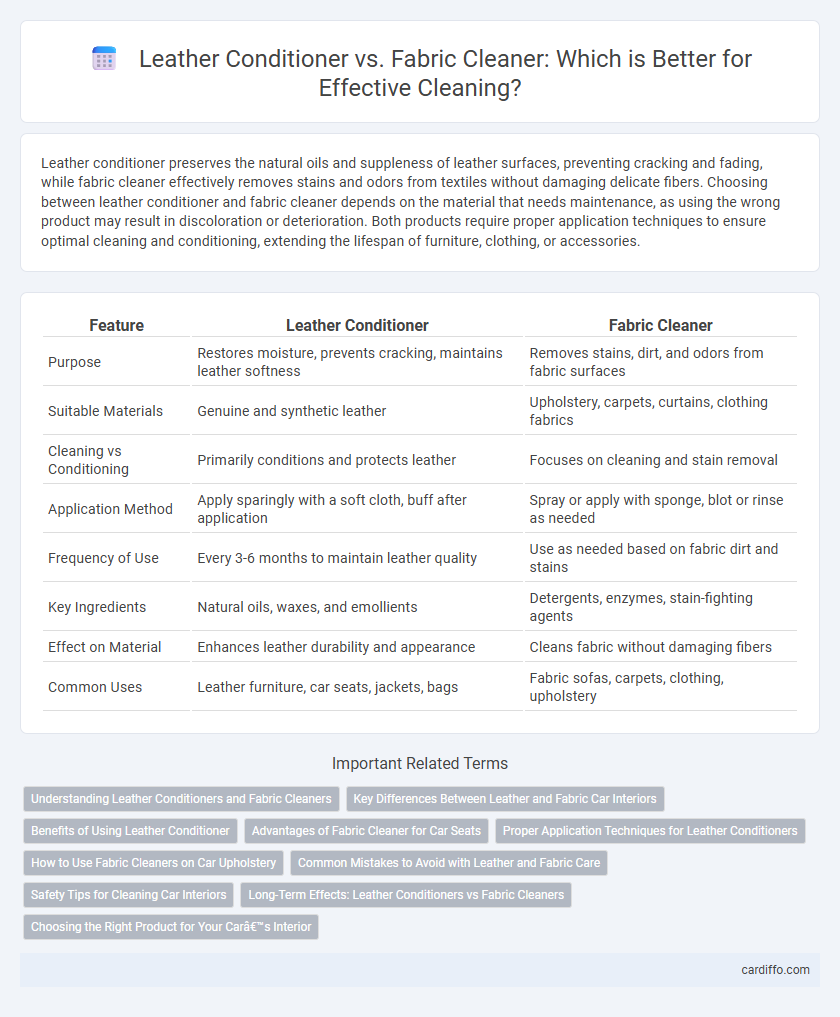Leather conditioner preserves the natural oils and suppleness of leather surfaces, preventing cracking and fading, while fabric cleaner effectively removes stains and odors from textiles without damaging delicate fibers. Choosing between leather conditioner and fabric cleaner depends on the material that needs maintenance, as using the wrong product may result in discoloration or deterioration. Both products require proper application techniques to ensure optimal cleaning and conditioning, extending the lifespan of furniture, clothing, or accessories.
Table of Comparison
| Feature | Leather Conditioner | Fabric Cleaner |
|---|---|---|
| Purpose | Restores moisture, prevents cracking, maintains leather softness | Removes stains, dirt, and odors from fabric surfaces |
| Suitable Materials | Genuine and synthetic leather | Upholstery, carpets, curtains, clothing fabrics |
| Cleaning vs Conditioning | Primarily conditions and protects leather | Focuses on cleaning and stain removal |
| Application Method | Apply sparingly with a soft cloth, buff after application | Spray or apply with sponge, blot or rinse as needed |
| Frequency of Use | Every 3-6 months to maintain leather quality | Use as needed based on fabric dirt and stains |
| Key Ingredients | Natural oils, waxes, and emollients | Detergents, enzymes, stain-fighting agents |
| Effect on Material | Enhances leather durability and appearance | Cleans fabric without damaging fibers |
| Common Uses | Leather furniture, car seats, jackets, bags | Fabric sofas, carpets, clothing, upholstery |
Understanding Leather Conditioners and Fabric Cleaners
Leather conditioners are specially formulated to nourish and protect leather surfaces by replenishing natural oils and preventing cracks, while fabric cleaners target dirt, stains, and odors on textiles without damaging fibers. Understanding the chemical composition and intended use of each ensures optimal cleaning results and prolongs material lifespan. Choosing the right product involves recognizing that leather requires hydrating agents, whereas fabric cleaners rely on surfactants and enzymes for effective stain removal.
Key Differences Between Leather and Fabric Car Interiors
Leather conditioner nourishes and protects natural leather car interiors by preventing cracking and maintaining suppleness, while fabric cleaner targets cloth seats by removing stains, dirt, and odors effectively. Leather requires gentle, pH-balanced products that preserve its texture and appearance, whereas fabric needs deeper cleaning solutions to lift embedded grime without causing discoloration. Understanding these key differences ensures the proper maintenance and longevity of each interior type.
Benefits of Using Leather Conditioner
Leather conditioner restores natural oils to maintain leather's softness, flexibility, and durability, preventing cracks and premature aging. It forms a protective barrier against moisture, dirt, and stains, extending the lifespan of leather goods like furniture, jackets, and car seats. Regular use of leather conditioner preserves the material's rich appearance, enhances color retention, and reduces the need for costly repairs or replacements.
Advantages of Fabric Cleaner for Car Seats
Fabric cleaners for car seats offer superior stain removal and odor elimination compared to leather conditioners, making them ideal for maintaining upholstery made of cloth or synthetic fibers. They penetrate deeply into fabric fibers, effectively breaking down dirt, sweat, and spills without causing damage or discoloration. Fabric cleaners also dry quickly and provide a fresh scent, enhancing the overall comfort and appearance of car interiors.
Proper Application Techniques for Leather Conditioners
Applying leather conditioner requires using a soft, lint-free cloth to gently rub the product into the leather surface in circular motions, ensuring even absorption without oversaturating. It's essential to test the conditioner on a small, inconspicuous area first to prevent discoloration or damage, allowing the leather to dry completely before use. Proper application restores leather's natural oils, enhances durability, and maintains its supple texture while preventing cracking and drying over time.
How to Use Fabric Cleaners on Car Upholstery
Fabric cleaners on car upholstery require a thorough vacuuming to remove loose dirt before application. Apply a small amount of fabric cleaner to a microfiber cloth, then gently blot or scrub the upholstery in circular motions to lift stains and dirt effectively. Allow the area to air dry completely, avoiding direct sunlight to prevent discoloration and ensure the fabric retains its texture and durability.
Common Mistakes to Avoid with Leather and Fabric Care
Using fabric cleaner on leather surfaces can cause discoloration and damage to the material's natural oils, leading to cracking and premature aging. Avoid applying leather conditioner on fabric upholstery, as it may leave residue that attracts dirt and causes staining. Always select products specifically formulated for each material type to maintain durability and appearance.
Safety Tips for Cleaning Car Interiors
When cleaning car interiors, using the appropriate product is essential for safety and material preservation; leather conditioners are specifically formulated to moisturize and protect leather surfaces without causing damage, while fabric cleaners are designed to remove stains and dirt from cloth seats without fading or weakening fibers. Always test any cleaner or conditioner on a small, inconspicuous area first to prevent discoloration or damage. Avoid harsh chemicals, ensure proper ventilation, and follow manufacturer instructions to maintain the integrity and appearance of both leather and fabric car interiors.
Long-Term Effects: Leather Conditioners vs Fabric Cleaners
Leather conditioners penetrate and nourish leather fibers, enhancing durability and preventing cracks over time, which extends the lifespan of leather goods. Fabric cleaners primarily remove stains and dirt but may strip natural oils from fabric fibers, potentially leading to weakened material and color fading with repeated use. Choosing a leather conditioner supports long-term maintenance by preserving suppleness, while fabric cleaners require careful selection to avoid degrading fabric integrity.
Choosing the Right Product for Your Car’s Interior
Leather conditioner enhances the durability and appearance of leather seats by moisturizing and preventing cracks, while fabric cleaner targets stains and dirt on cloth upholstery without causing damage. Selecting the right product depends on the material of your car's interior; use leather conditioner exclusively on genuine leather surfaces and fabric cleaner for cloth or synthetic fabrics. Proper product choice preserves the interior's quality, extends lifespan, and maintains resale value effectively.
Leather Conditioner vs Fabric Cleaner Infographic

 cardiffo.com
cardiffo.com